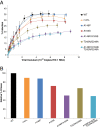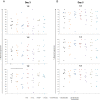CD8+ T cells from HLA-B*57 elite suppressors effectively suppress replication of HIV-1 escape mutants
- PMID: 24330837
- PMCID: PMC3878989
- DOI: 10.1186/1742-4690-10-152
CD8+ T cells from HLA-B*57 elite suppressors effectively suppress replication of HIV-1 escape mutants
Abstract
Background: Elite Controllers or Suppressors (ES) are HIV-1 positive individuals who maintain plasma viral loads below the limit of detection of standard clinical assays without antiretroviral therapy. Multiple lines of evidence suggest that the control of viral replication in these patients is due to a strong and specific cytotoxic T lymphocyte (CTL) response. The ability of CD8+ T cells to control HIV-1 replication is believed to be impaired by the development of escape mutations. Surprisingly, viruses amplified from the plasma of ES have been shown to contain multiple escape mutations, and it is not clear how immunologic control is maintained in the face of virologic escape.
Results: We investigated the effect of escape mutations within HLA*B-57-restricted Gag epitopes on the CD8+ T cell mediated suppression of HIV-1 replication. Using site directed mutagenesis, we constructed six NL4-3 based viruses with canonical escape mutations in one to three HLA*B-57-restricted Gag epitopes. Interestingly, similar levels of CTL-mediated suppression of replication in autologous primary CD4+ T cells were observed for all of the escape mutants. Intracellular cytokine staining was performed in order to determine the mechanisms involved in the suppression of the escape variants. While low baseline CD8+ T cells responses to wild type and escape variant peptides were seen, stimulation of PBMC with either wild type or escape variant peptides resulted in increased IFN-γ and perforin expression.
Conclusions: These data presented demonstrate that CD8+ T cells from ES are capable of suppressing replication of virus harboring escape mutations in HLA-B*57-restricted Gag epitopes. Additionally, our data suggest that ES CD8+ T cells are capable of generating effective de novo responses to escape mutants.
Figures





Similar articles
-
Maintenance of viral suppression in HIV-1-infected HLA-B*57+ elite suppressors despite CTL escape mutations.J Exp Med. 2006 May 15;203(5):1357-69. doi: 10.1084/jem.20052319. Epub 2006 May 8. J Exp Med. 2006. PMID: 16682496 Free PMC article.
-
Viral suppression of multiple escape mutants by de novo CD8(+) T cell responses in a human immunodeficiency virus-1 infected elite suppressor.Retrovirology. 2011 Aug 3;8:63. doi: 10.1186/1742-4690-8-63. Retrovirology. 2011. PMID: 21812985 Free PMC article.
-
De novo generation of escape variant-specific CD8+ T-cell responses following cytotoxic T-lymphocyte escape in chronic human immunodeficiency virus type 1 infection.J Virol. 2005 Oct;79(20):12952-60. doi: 10.1128/JVI.79.20.12952-12960.2005. J Virol. 2005. PMID: 16188997 Free PMC article.
-
The influence of HLA/HIV genetics on the occurrence of elite controllers and a need for therapeutics geotargeting view.Braz J Infect Dis. 2021 Sep-Oct;25(5):101619. doi: 10.1016/j.bjid.2021.101619. Epub 2021 Sep 22. Braz J Infect Dis. 2021. PMID: 34562387 Free PMC article. Review.
-
Qualitative features of the HIV-specific CD8+ T-cell response associated with immunologic control.Curr Opin HIV AIDS. 2011 May;6(3):169-73. doi: 10.1097/COH.0b013e3283454c39. Curr Opin HIV AIDS. 2011. PMID: 21399496 Free PMC article. Review.
Cited by
-
The Breadth of Expandable Memory CD8+ T Cells Inversely Correlates with Residual Viral Loads in HIV Elite Controllers.J Virol. 2015 Nov;89(21):10735-47. doi: 10.1128/JVI.01527-15. Epub 2015 Aug 12. J Virol. 2015. PMID: 26269189 Free PMC article.
-
Glycoproteomic study reveals altered plasma proteins associated with HIV elite suppressors.Theranostics. 2014 Sep 18;4(12):1153-63. doi: 10.7150/thno.9510. eCollection 2014. Theranostics. 2014. PMID: 25285165 Free PMC article.
-
More than the Infinite Monkey Theorem: NHP Models in the Development of a Pediatric HIV Cure.Curr HIV/AIDS Rep. 2024 Feb;21(1):11-29. doi: 10.1007/s11904-023-00686-6. Epub 2024 Jan 16. Curr HIV/AIDS Rep. 2024. PMID: 38227162 Free PMC article. Review.
-
The Effect of Latency Reversal Agents on Primary CD8+ T Cells: Implications for Shock and Kill Strategies for Human Immunodeficiency Virus Eradication.EBioMedicine. 2016 Jun;8:217-229. doi: 10.1016/j.ebiom.2016.04.019. Epub 2016 Apr 18. EBioMedicine. 2016. PMID: 27428432 Free PMC article.
-
Consequences of HLA-B*13-Associated Escape Mutations on HIV-1 Replication and Nef Function.J Virol. 2015 Nov;89(22):11557-71. doi: 10.1128/JVI.01955-15. Epub 2015 Sep 9. J Virol. 2015. PMID: 26355081 Free PMC article.
References
-
- Deacon NJ, Tsykin A, Solomon A, Smith K, Ludford-Mending M, Hooker DJ, McPhee DA, Greenway AL, Ellett A, Chatfield C, Lawson VA, Crowe S, Maerz A, Sonza S, Learmont J, Sullivan JS, Cunningham A, Dwyer D, Dowton D, Mills J. Genomic structure of an attenuated quasi species of HIV-1 from a blood transfusion donor and recipients. Science. 1995;10:988–991. doi: 10.1126/science.270.5238.988. - DOI - PubMed
Publication types
MeSH terms
Substances
Grants and funding
LinkOut - more resources
Full Text Sources
Other Literature Sources
Research Materials

